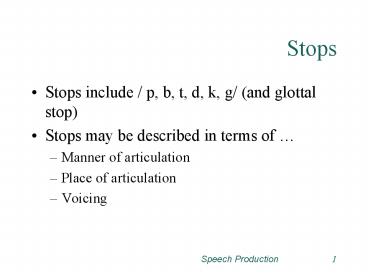Stops PowerPoint PPT Presentation
1 / 23
Title: Stops
1
Stops
- Stops include / p, b, t, d, k, g/ (and glottal
stop) - Stops may be described in terms of
- Manner of articulation
- Place of articulation
- Voicing
2
Manner
- All stops have same manner of articulation
- Sudden burst of air or sudden stop in the burst
of air. - All have an aperiodic sound source
- All produced from mouth (as opposed to nares)
- Rapid changes in articulators result in rapid
change in acoustic resonance.
3
Place
- Place of articulation refers to where the major
constriction occurs. - Bilabial /p, b/
- Alveolar (lingua-alveolar) /t, d/
- Palatal (lingua-palatal) /k, g/
- Note may be velar depending upon vowel context.
- Glottal
4
Place
5
Spectrograms of Stops
6
Voicing
- /p, b, k/ are unvoiced
- Contain only an aperiodic component
- /b, d, g/ are voiced
- Contain both periodic and aperiodic component
7
Fricatives
- Fricatives include
- Similar to stops
- Both contain an aperiodic noise source
- Both have a place of maximum constriction
- Both may be voiced or unvoiced
- Different than stops
- Manner of articulation fricatives involve only
a partial constriction of vocal tract.
Fricatives are sometime referred to a continuants.
8
Place and voicing
9
Place and voicing
10
(No Transcript)
11
Affricates
- Combination of a stop and fricative .
12
Sound Influence
- Adaptation
- Assimilation
- Coarticulation
13
Adaptation
- Variations in articulators as they move from one
articulator to another resulting in different
allophones. - E.g., key vs. coo . /ki/ vs. /ku/ or pea vs.
pooh . /pi/ vs. /pu/ - In both instances the production of the stop has
been altered due to vowel context.
14
Assimilation
- Extreme form of adaptation where production of
phoneme is changed due to context. - E.g., the word think
15
Coarticulation
- Two articulators moving at the same time for
different phonemes. - E.g., /tu/. Lips are protruded in anticipation
of /u/ - During running speech coarticulation (along with
adaptation and assimilation) occur constantly.
16
Suprasegmentals
- Sometimes referred to as prosody.
- Provide examples
- Give speech its color, expression and sbutle
meaning - Suprasegmentals include
- Stress
- Intonation
- Duration and juncture
17
Stress
- Increase in
- Effort
- Intensity
- Pitch
- Duration
- Formant pattern
18
Stress (continued)
- Acoustic events
- Increase in fo
- Formants not affected by adaptation
- Higher muscle activity (e.g., emg)
- Vowels have longer duration and are of greater
intensity due to increase in subglottal air
pressure.
19
Intonation
- Change in fundamental frequency.
20
Intonation (continued)
- Changing intonation can change meaning may
signal attitude and feelings. - Rising inflection can signal difference between
statement and question. - Flat intonation sometimes implies seriousness
- Can denote sarcasm
- May indicate excitement, etc.
21
Intonation (continued)
22
Duration and Junction
- Duration
- Usually involves changing length of vowel.
- May be volitional or involuntary
- Vowel before a voiced phoneme is longer than what
occurs before an unvoiced consonant. E.g., wet
vs. wed - Juncture
- Combination of changes in stress and duration can
cause change in meaning. - E.g., a name vs. an aim, Contest can mean either
games, or a challenge depending upon context.
23
Summary

